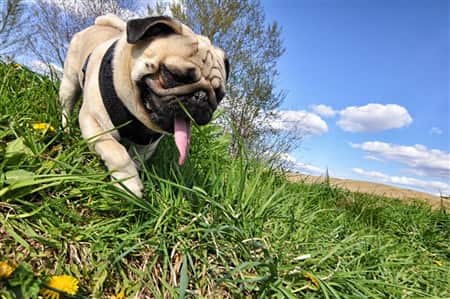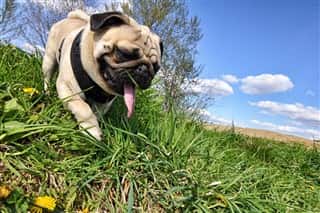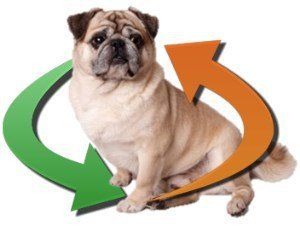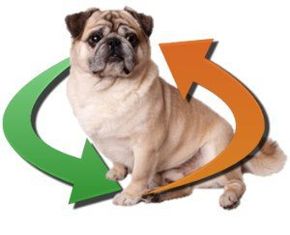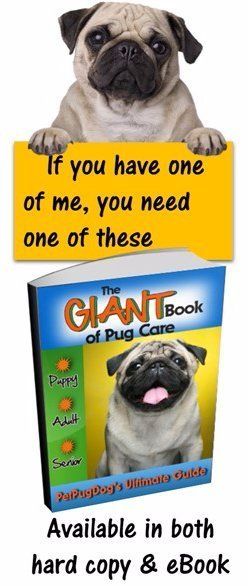Pug Dogs
Your One-Stop Pug Dog Information Center
The Pug is a thick coated, sturdy, barrel-shaped brachycephalic breed. He has an endearing personality and bonds very closely with his humans.
A bit sensitive to his surroundings, but always willing to try his best in all regards, the Pug makes for a wonderful canine family member.
This site is dedicated to the Pug breed and offers care tips and a wide range of articles to help owners achieve optimal health, comfort, safety and happiness for their Pugs.
Become a Free Member
This allows you to:
- Know when new pages of information are added to this site
- Suggest a topic for us to write about
- Be able to submit photos of your Pug to be added here
- Receive friendly reminders pertaining to Pug dog info
"I sometimes think that God, in creating the Pug,
somewhat underestimated his ability" ~Oscar Wilde
New Right Now:
How to Keep a Pug Dog Clean - This breed tends to get stinky quite easily. See our tops tips for keeping a Pug puppy or adult dog looking tidy and smelling nice.
Recent Articles:
Home Cooking for a Pug
- If you're considered preparing meals at home, you'll want to check this out. Includes 5 quick facts to know, the top 8 benefits, and the introduction of a super-colorful and amazingly fun cookbook (PDF).
Pug Spay and Neuter Information
- Everything you need to know about having a female spayed or a male neutered. Pros and cons, known and suspected risks, myths, the best age to have this done, recovery and post-op care, and FAQ.
Pug Breathing Problems
- Why Pugs have so many breathing issues and the top 10 things you can do to help your Pug breathe better.
Pug Dog Shedding
- Updated
- Tons of hairs fall off but become stuck deep within the dense coat of this breed. Are you successfully pulling them all out? Read all the details about how Pugs shed, the best tools to pull out dead fur, and brushing tips.
Pug Feeding Guidelines
- Updated
- Covers every detail regarding how much, how often, dry vs wet, and the best choices for optimal health. Includes the latest info regarding grain-free foods and the suspected link to DCM.
Pug Smells and Odors
- A comprehensive and helpful guide to fixing every possible type of of odd smell or odor.
Pug Exercise
- Updated
- A full guideline to making sure your Pug meets exercise requirements while being aware of this breed's limitations. Helpful tips for walks, organized cardio, and alternative activities.
Pug Dental Care
- Updated
- Brachycephalic breeds like the Pug need routine at-home care or there can be future consequences including decay and tooth loss. This article also covers bite set and common problems.
Leaving a Pug Home Alone
- Updated
- This entire article has been completely redone with easy-to-follow steps and newly discovered aids to help keep a Pug happy, comfortable, and calm when you have to leave.
10 Super Fun Things to Do With Your Pug
- Your Pug is your best friend, right? But, do you need to spend more quality time together? Read 10 fun things to do with your puppy or dog both at home and if you feel like getting out for a while
Pug Dog Paw Care
- This extensive article covers the top 10 most common paw issues: Dry skin, burns, reactions to irritants, yeast infection, snowballing, unexplained itchiness, loss of traction, cracked skin, sores, and minor injuries. This guide will help you keep your Pug's healthy and know how to treat these stubborn issues mainly with at-home remedies.
How to Keep a Pug Dog Busy
- If your Pug is bored silly while you're gone or when you're not able to pay attention to them, see how to keep a Pug super happy, engaged, and occupied.
When a Pug Keeps Missing the Pee Pads
- Part of housebreaking is setting up pee pads that should be used when you're not home; but, it's not uncommon for a dog to ignore them or miss the target. Helpful tips to get your Pug back on track.
How to House Train a Pug
- Updated
- This section has been completely updated for faster, more effective success.
Top 10 Pug Dog Eating Issues
- A super-helpful roundup of the 10 problems that can be happening along with exact steps to resolve them.
How to Cure Pug Dog Itchiness
- The top reasons a Pug will be itchy and exact step-by-step instructions to immediately help your Pug feel better.
Pug is Acting Odd
- A great article covering the most common strange behaviors, reasons, and what to do.
Pug is Licking or Chewing at the Paws
- Paying attention to the paws can quickly spiral out of control, leading to broken skin, damaged hair follicles, and sores. See the top 6 reasons why Pugs do this. And, even if you cannot identify the trigger, see exactly how to offer immediate relief.
The Best Type of Supplements for Pug Dogs
- Not every Pug puppy or dog needs to be given supplement; but for certain issues, these can be very beneficial. See which supplement does what, and dosing instructions.
Playpens for Pugs
- See how a canine playpen can make a world of difference for your Pug puppy or dog.
The Top Shampoos for a Pug
- See how shampoos, conditioners, and leave-in coat sprays can make a dramatic difference in regard to your Pug's skin and coat. Also covers medicated shampoos.
Overview of Pug Colors & Markings
This breed is unique in the fact that there are only 2 basic AKC recognized colors.
- Black: This color can appear in 1 of 3 ways: As a solid), as a secondary color or as part of a brindle coat (rare and not an officially recognized color). Black with a 2nd color will place the Pug dog into the black with 'mis-mark' category.
- Fawn: This is the most common color of this breed. In the United States, current stats of registered Pug dogs show the percentage of fawn at 64%.
There are also variations of fawn. This includes:
- Apricot Fawn - The apricot can range from a light yellow to a deep, rich orange.
- Silver fawn: The color that is most rare. Because of breeding throughout generations, a solid sliver is hard to find, especially in the USA. More common is the parti silver/fawn.
Markings: There are 3 types of markings:
1)
The trace - This is a line of black, some are thin and distinct, some are faded into the coat, that runs from the back of the neck to the rump.
2)
The mask - This is the black skin pigmentation and hairs on the face.
3)
A mark on the forehead called the thumbprint, also known as the diamond
Read More: Colors
Pug Dog Stats
Pronounced:
puhg
Origin of Name:
Theory 1:Derived from the Latin word Pugnus, meaning 'fist'. Theory 2:
A term coined in 1731 as a nickname for a monkey or a dog. Theory 3:
A variation of the word 'puck', a mischievous fairy in the works of Shakespeare's
Alternative Names:Chinese pug, Dutch bulldog, Dutch mastiff, Mini mastiff, Mop, Carlin
Ancient Names: Foo, Fu dog, Lo-Chafing-See, Lo- Chafing and Pia dog
Family:
Mastiff
Breed Group:
AKC, FCI, KC and CKC Toy
Date of Recognition:
AKC 1885, FCI 1966
Height, Males:
12-14 inches (30-36 cm)
Height, Females:
10-12 inches (25-30 cm)
Weight, Male and Female, AKC: 14 to 18 pounds (6.35 to 8.16 kg)
Weight, Male and Female, CKC, KC, FCI: 6.3 kg to 8.1 kg (13.88 to 17.85 lbs.)
The Pug is the largest of all of the toy breed dogs. Although top expected weight is 18 pounds, this can be exceeded. Be sure you are following proper feeding guidelines if your dog is under or overweight.(See: Weight)
Life Expectancy:
12-15 years (See: Life Span)
Litter Size:
4-6
Origin:
Asia
Date of Origin:
400 BC
Purpose:
Indoor Companion dog
Breed Qualities:
Loyal, animated, playful, closely bonds with humans, amusing noise maker, heavy shedder
Popularity:
Consistently in the top 8 most owned toy breeds, U.S.,Canada and UK
Intelligence:
#57
Maturity Rate:
Adult at 1 year mark (See: Age Chart)
Popular Sections
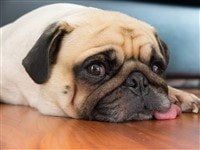
It's very common for Pug dogs to struggle with being home alone. This breed has been bred for centuries to be a perfect companion, so not having his humans nearby can bring about overwhelming stress and loneliness
Luckily, there are several steps you can take to help your Pug feel safe and secure until your arrival back.

Though dogs can exist with very little, if you really want your Pug to thrive, it will be important to have the right supplies. And more is not always better. You'll find that if you take the time to choose what he really needs, those select items will help him be comfortable, safe, happy, and even bring about a healthier puppy or dog.

Itchy skin? Sore spots? Breathing issues? Your Pug may showing showing reactions to an allergen. It is not uncommon for this breed to have a low tolerance to a wide variety of elements, including food, contact elements (soaps, cleansers, bedding, carpeting) and inhaled pollutants (weeds, grasses, pollen).
Studies show that at least 20% of canines suffer from at least one form of allergies. The good news? By making some key changes and, for some, incorporating medications, most allergies can be controlled and managed quite well.
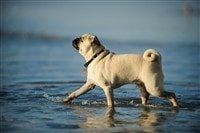
All breeds are prone to certain conditions and diseases and the Pug is no exception. Being both a small dog and a brachycephalic breed, the Pug can have issues related to size, hip problems, and breathing difficulties among other things. Read about general health, signs and symptoms, prevention and treatment.
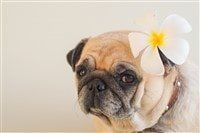
Gender Related - Male VS Female Pugs
- A look at the differences between genders.
Female related articles include:
Heat
- When you have a girl Pug, be sure to have all the facts concerning heat cycles. The average age that this begins is 6 months old, however some dogs enter as young as 4 months old and some as late as 8 months.
If your un-spayed, female Pug dog has not had her first cycle by the age of 9 months, be sure to bring her for a complete medical check up.
Pregnancy- This is another important topic that will affect 8% of owners who are caught off guard. If you have no plans to breed, do please consider spaying. If you have an expectant Pug, you'll be interested to read through our section devoted to this.
Providing canine prenatal care is vital for the health of the coming litter of puppies and to ensure the safety of the dam.
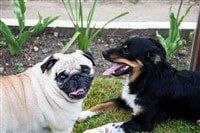
An interesting look at how the Pug compares to other dog breeds in all aspects. History, size, coat, color, behavior and more.
Also, a comparison of the Pug in regard to the various groups that dogs can be categorized.
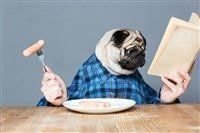
What you offer your Pug for both meals and snacks plays a huge role in his overall health; both now and for the future. While some Pugs may be a bit fussy, choosing the best foods will allow him to grow as he should, help him maintain his weight and offer him proper nutrition needed for health, a strong immune system and good digestion.
Behavior, Traits and Character
Looking for a dog with personality? You've found him!
This breed is simply one of the most expressive and truly comical dogs on the planet.
Expressing a range of emotions, the Pug is a wonderful canine family member
and he'll work to show you that he's more than just a pet.
He can be a bit demanding, yet will exert tons of energy to make you smile.
This is not a breed that is meant to be independent; most Pugs will crave human companionship
and will shadow their owners.
The best words to sum up this amazing breed are: loyal, friendly, amusing and charming.
An indoor dog and one that needs to be well-groomed in order to maintain health,
the Pug does best in a household that can provide plenty of time for care and attention.
As Your Pug Ages
Being a toy breed, the Pug will age a bit faster than larger dogs. Technically, this breed is only a puppy until the end of year one. The old notion that a dog ages 7 years for each human year does not hold true. Growth actually happens in spurts. Some years will see less than the equivalent of 7 human years and some will be closer to this number.
Elements involving just about all care aspects will need to be adjusted for an older Pug including meals and exercise.
We offer a helpful aging section, along with helpful information regarding the older, wiser Pug dog. Read more: Senior Pugs
Grooming Overview
It's hard to believe that such a short coated dog could shed as much as he does, but the Pug dog is one of the heaviest shedding purebreds.
Just about all dogs have a coat that goes through 3 continual cycles: Anagen (hair is growing), Catagen (fur growth stops and is at rest) and Telogen (follicles rest and die off, resulting in shedding).
A dog's coat of fur will not be in any one particular stage all at the same time. The reason why the Pug breed sheds so much is that he has a very rapid continual cycle of these 3 stages. On just about any given day, a higher than average percentage of the coat is in the Telegen (falling off) phase.
Good grooming practices can keep both skin and coat healthy. Brushing and bathing at certain intervals will be an important part of caring for a Pug. Special attention should be given to the: Eye area, ears, mouth, facial folds (wrinkles) and nails.
Popular Informational Sections:
Dental Care
- Taking care of your Pug's teeth is vital. There are steps you can take from home to keep teeth clean.
Ear Care
- Be on the lookout for infections. Cleaning the ears can help prevent and treat this.
Fur Loss
- Thinning or balding areas can be due to one of several reasons.
Shedding
- This breed is a high shedder, lots of brushing with the right tools will help.
Grooming
- An overview of all grooming elements to keep your Pug clean and keep skin in good shape.
Smells and Odors
- Reasons why a Pug may start to smell funny and what you can do to help your Pug smell nice.
Skin Issues
- Problems with the skin are not uncommon with this breed due to skin wrinkles and folds.
Around the Pug in 60 Seconds
The Pug dog is classified in the AKC toy group, the largest of all toy breeds. He is known for his distinctive wrinkles, flat face, and short, curled tail. Some other distinguishing characteristics are the ears. There are 2 different ears shapes: rose and button and both are accepted in the AKC breed standard, although buttons are preferred in show confirmation.
Part of what makes this dog so endearing is his under-bite, in which the lower jaw protrudes out further than the upper.
The coat is short and shiny, and only found in a few colors: fawn (including silver and apricot fawn), black, and some rare silvers. The Pug’s body is barrel shaped, with a short neck and wide, thick chest.
This, combined with the flat brachycephalic face gives us a wonderfully unique dog that does need to be watched for over exertion, overheating issues and breathing issues.
Generations of careful breeding have given us the dog that we know today and the Pug itself was used in creating other breeds such as the English Bulldog and the Pekingese. Pugs were first bred in rural China during the Shang Dynasty (thought to exist some time before 400 BC).
During this time, they were referred to as both Foo and Lo-Chiang-Sze. His unique appearance became quite cherished and the majority of Pugs were gathered up and brought into Tibet. It would be quite a while before this breed was thought of as a “normal” pet for the family. For quite a while, only Buddhist monks kept watch over Pugs.
Several hundred years later, a ruler made sure that this breed would remain a mystery when he ordered all artwork, papers and anything that held Pug dog references and proof of origin to be destroyed. This was done by Emperor Qin Shi Huang, the first official Emperor of China, who ruled from 221 to 210 BC.
In the 1500’s the Pug was brought into Europe and quickly became popular in countries such as France and Italy. This amazing breed was treated like royalty, often being dressed in pantaloons and jackets and riding in the front of private horse drawn carriages.
Later, Pug dogs were used as both guard dogs and military dogs. This breed became very popular in England during the 1800’s and in 1885 the AKC (American Kennel Club) recognized the Pug. Since that time, the Pug has almost always appeared in the top 20 most popular dog breeds.
Pug Dog Breed Standard Information
Every recognized purebred dog breed in the world has a breed standard. The standard is a written description of the physical features that a dog should possess and it also may include temperament qualities.
These elements combine together to describe what a typical breed should look like. While not every Pug will exactly match the standard, for example weight or height may be slightly off, the description as a whole represents the Pug breed. It serves as a guide for breeders to follow when pairing dogs, and as a guiding principle for judges in confirmation events.
These confirmation standards of the Pug have changed over time. The first written ideal was created in 1885 England. They were updated by the Pug Dog Club of America in 1931. The AKC, working in conjunction with the PDC of A make slight modifications every so often.
The qualities a Pug should embody:
Overall body shape should be square, compact and have well developed muscles along with a thick neck, short back and strong legs. The Pug would not be described as long nor lean. His head is large and round with a short, squared off muzzle. The bite should be slightly undershot, which means that the lower jaw protrudes out a bit more than the upper jaw.
The eyes are large, dark and a prominent feature. Ears are thin and small, described as black velvet. Wrinkles are an important physical feature of the Pug dog; expected to be noticeable, large and deep. A Pug’s tail
should be curled with a double curl preferred in the show ring. The coat should be short, smooth and shiny.
Colors are fawn (which includes silver and apricot fawn) and black. The muzzle will be covered with a black mask, the forehead will have a black mark called a thumbprint and a line of black will run down the center of the Pug’s back (called the trace). Pug dogs are even-tempered, playful, charming, outgoing and have a loving personality.


